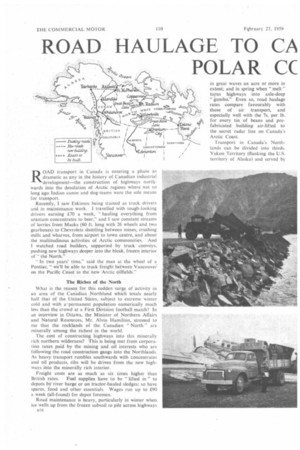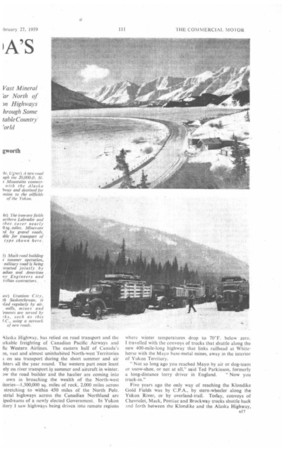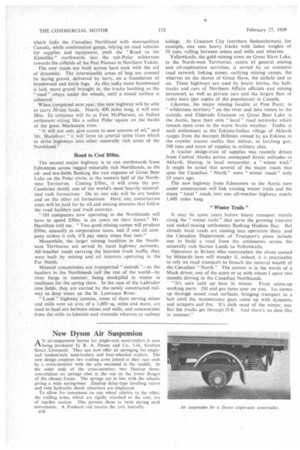ROAD HAULAGE TO CA POLAR CC
Page 50

Page 51

Page 52

If you've noticed an error in this article please click here to report it so we can fix it.
ROAD transport in Canada is entering a phase as dramatic as any in the history of Canadian industrial development—the construction of highways northwards into the desolation of Arctic regions where not so long ago Indian canoe and dog-teams were the sole means for transport
Recently, I saw Eskimos being trained as truck drivers and in maintenance work. I travelled with tough-looking drivers earning £70 a week, "hauling everything, from uranium concentrates to beer," and I saw constant streams of lorries from Macks (60 ft, long with 26 wheels and two gearboxes) to Chevrolets shuttling between mines, crushing mills and wharves, from airport to town centre, and about the multitudinous activities of Arctic communities. And I watched road builders, supported by truck convoys, pushing new highways deeper into the bleak, frozen interior of "the North." .
" In two years' time," said the man at the wheel of a Pontiac, "we'll be able to truck freight between Vancouvei= on the Pacific Coast to the new 'Arctic oilfields."
The Riches of the North
What is the reason for this sudden surge of activity in an area of the Canadian Northland which totals nearly half that of the United States, subject to extreme winter cold and with a-permanent population numerically much less than the crowd at a First Division football match? In an interview in Ottawa, the Minister of Northern Affairs and Natural Resources, Mr. Alvin Hamilton, stressed to me that the rocklands of the Canadian " North " are minerally among the richest in the world.
The cost of constructing highways into this minerally rich northern wilderness? This is being met from corporation taxes paid by the mining and oil interests who are following the road construction gangs into the Northlands. As heavy transport rumbles southwards with concentrates and oil products, ribs will be driven from the new highways into the minerally rich interior.
Freight costs are as much as six times higher than British rates. Fuel supplies have to be "lifted in" to depots by river barge or on tractor-hauled sledges; so have spares, food and other essentials. Wages run up to £90 a week (all-found) for depot foremen, Road maintenance is heavy, particularly in winter when ice wells up from the frozen subsoil to pile across highways in great waves an acre or more in extent; and in spring when " melt " turns highways into axle-deep "gumbo." Even so, road haulage rates compare favourably with those of air transport, and especially well with the 7s. per lb. for every tin of beans and prefabricated building air-lifted to the secret radar line on Canada's Arctic Coast.
Transport in Canada's Northlands can be divided into thirds. Yukon Territory (flanking the U.S. territory of Alaska) and served by Alaska Highway, has relied on road transport and the irkable freighting of Canadian Pacific Airways and he Western Airlines. The eastern half of Canada's
vast and almost uninhabited North-west Territories 3 on sea transport during the short summer and air • hters all the year round. The western part once leant ely on river transport in summer and aircraft in winter. Jw the road builder and the haulier are coming into own in broaching the wealth of the North-west itories-1,300,000 sq. miles of rock, 2,000 miles across stretching to within 450 miles of the North Pole. strial highways across the Canadian Northland arc ipedreams of a newly elected Government. In Yukon itory I saw highways being driven into remote regions where winter temperatures drop to 70°F. below zero. I travelled with the convoys of trucks that shuttle along the new 400-mile-long highway that links railhead at Whitehorse with the Mayo base-metal mines, away in the interior of Yukon Territory.
"Not so long ago you reached Mayo by air or dog-team or snow-shoe, or not at all," said Ted Parkinson, formerly a long-distance lorry driver in England. "Now you truck-in."
Five years ago the only way of reaching the Klondike Gold Fields was by C.P.A., by stern-wheeler along the Yukon River, or by overland-trail. Today, convoys of Chevrolet, Mack, Pontiac and Brockway trucks shuttle back and forth between the Klondike and the Alaska Highway, which links the Canadian Northland with metropolitan Canada, while construction gangs, relying on road vehicles for supplies and equipment, push the " Road to the Klondike northwards into the sub-Polar wilderness towards the oilfields of the Peel Plateau in Northern Yukon.
The new roads are built across bare rock with the aid of dynamite. The interminable areas of bog are crossed by laying gravel, delivered by lorry, on a foundation of brushwood and birch logs. As this sinks more brushwood is laid, more gravel brought in, the trucks lurching as the " road " sways under the wheels, until a sound surface is achieved.
When completed next year, this new highway will be able to carry 50-ton" loads. Nearly 400 miles long, it will cost $8m. Its terminus will be at Fort McPherson, an Indian settlement sitting like a sullen Polar squaw on the banks of the great Mackenzie river.
"It will not only give access to new sources of oil," said Mr. Hamilton; " it will form an arterial spine from which to drive highways into other minerally rich areas of the Northland."
Road to Cost $50m.
The second major highway is to run northwards from Edmonton across rugged minerally rich Northlands, to the oiland ore-fields flanking the vast expanse of Great Bear Lake on the Polar circle, in the western half of the Northwest Territories. Costing $50m., it will cross the preCambrian shield, one of the world's most heavily mineralized rock formations. On its one side will be ore bodies and on the other oil formations. Here, too, construction costs will be paid for by oil and mining interests that follow the road builders and truck convoys.
"Oil companies now operating in the Northlands will have to spend $50m. in six years on their leases." Mr. Hamilton told me. "Two good mining camps will produce $50m. annually in corporation taxes, and if one oil company strikes it rich, it'll pay many times that sum."
Meanwhile, the larger mining localities in the Northwest Territories are served by local highway, networks. All-weather roads carrying the heaviest truck traffic, they were built by mining and oil interests operating in the Far North.
Mineral concentrates are transported " outside "—as the hauliers in the Northlands call the rest of the world—by river barge in summer, being stockpiled in winter in readiness for the spring thaw. In the case of the Labrador iron fields, they are carried by the newly constructed railway to deep water on the St. Lawrence River. " Local" highway systems, some of them serving mines and mills over an area of a 1,000 sq. miles and more, are used to haul ore between mines and mills, and concentrates from the mills to lakeside and riverside wharves or railway sidings. At Uranium City (northern Saskatchewan), for example, one sees heavy tricks with laden weights of 50 tons, rolling between mines and mills and wharves.
Yellowknife, the gold-mining town on Great Slave Lake, in the North-west Territories, centre of general mining and oil-exploration activities, is served by an extensive road network linking mines, outlying mining camps, the wharves on the shores of Great Slave, the airfield and so on. These highways are used by heavy lorries, the halftracks and cars of Northern Affairs officials and mining personnel, as well as private cars and the largest fleet of radio taxis (per capita of the population) in Canada.
Likewise, the major mining locality at Pine Point, in " wilderness territory" on the river and lake routes to the outside, and Eldorado Uranium on 9reat Bear Lake in the Arctic, have their own " local" road networks which remain open even in the worst Arctic weather. Traffic at such settlements as the Eskimo-Indian village of Aklavik ranges from the decrepit Hillman owned by an Eskimo to the crawler tractor outfits that deliver, in lurching gait, 500 tons and more of supplies to military sites.
A tractor sledge-train of supplies was recently driven from Central Alaska across unmapped Arctic solitudes to Aklavik, blazing, in local vernacular, a "winter trail." It might be noted that several of the major roads that span the Canadian " North " were " winter roads" only 10 years ago.
The new highway from Edmonton to the Arctic now under construction will link existing winter trails and the many " local" roads into one all-weather highway nearly 1,400 miles long.
"Winter Trails"
It may be some years before heavy transport travels along the " winter trails" that serve the growing iron-ore and nickel-mining settlements flanking Hudson Bay. But already local roads are coming into operation there, and the Canadian Department of Transport's plans include one to build a road from the settlements across the minerally rich Barren Lands to Yellowknife.
Operators in Britain who contemplate the chaos caused by blizzards here will wonder if, indeed, it is practicable to rely on road transport to broach the mineral wealth of the Canadian "North." The answer is in the words of a Mack driver, one of the score or so with whom I spent two months driving in the Canadian Northlands.
" It's sure cold up here in winter_ Frost seizes-up working parts. Oil and gas turns sour on you. Ice comes up through sound road surfaces, bringing transport to a halt until the maintenance guys come up with dynamite and scrapers and fire. It's dark most of the winter, too. But the trucks get through O.K. And there's no dust like in summer."




































































































